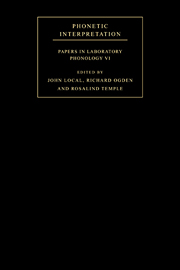Book contents
- Frontmatter
- Contents
- List of contributors
- Acknowledgements
- Introduction
- Part I Phonological representations and the lexicon
- Part II Phonetic interpretation and phrasal structure
- Part III Phonetic interpretation and syllable structure
- Part IV Phonology and natural speech production: tasks, contrasts and explanations
- 16 The interaction of the phonetics and phonology of gutturals
- 17 Pitch discrimination during breathy versus modal phonation
- 18 The phonetic interpretation of register: evidence from Yorùbá
- 19 Speech rhythm in English and Japanese
- 20 Commentary: on the interpretation of speakers' performance
- References
- Index of names
- Index of subjects
18 - The phonetic interpretation of register: evidence from Yorùbá
Published online by Cambridge University Press: 22 September 2009
- Frontmatter
- Contents
- List of contributors
- Acknowledgements
- Introduction
- Part I Phonological representations and the lexicon
- Part II Phonetic interpretation and phrasal structure
- Part III Phonetic interpretation and syllable structure
- Part IV Phonology and natural speech production: tasks, contrasts and explanations
- 16 The interaction of the phonetics and phonology of gutturals
- 17 Pitch discrimination during breathy versus modal phonation
- 18 The phonetic interpretation of register: evidence from Yorùbá
- 19 Speech rhythm in English and Japanese
- 20 Commentary: on the interpretation of speakers' performance
- References
- Index of names
- Index of subjects
Summary
Introduction
This paper is concerned with voice quality–pitch associations and their possible implications for theories of tonal register. A voice quality–pitch association is the systematic use of a particular voice quality to mark out a particular part of the phonational range or, in the case of a tone language, a particular tone. English is a possible example of a language which has a voice quality–pitch association. At least in the pronunciations with which we are familiar, the phonation type known as ‘creak’ may be, as it were, added to low pitches, for example in the low fall and fall–rise intonation tunes. In this way, creaky phonation (if used) is associated with the lower end of the phonational range. There is also some evidence that breathy voice may be associated with higher pitches (Pierrehumbert 1997). This is not usually commented on, but it is possible that English speakers are sensitive to it. One of the motivations of Pierrehumbert's work was to improve the quality of speech synthesis.
In some languages, an opposite type of association has been reported, with breathy voice being added to low pitches. An example is Kalam Kohistani, for which Baart (1999: 92) reports that vowels which have low tone may be pronounced with breathy voice, especially when they occur in word-initial syllables. Such examples demonstrate that the (consistent or potential) association of creaky voice with low pitch is not universal.
- Type
- Chapter
- Information
- Phonetic InterpretationPapers in Laboratory Phonology VI, pp. 305 - 321Publisher: Cambridge University PressPrint publication year: 2004

